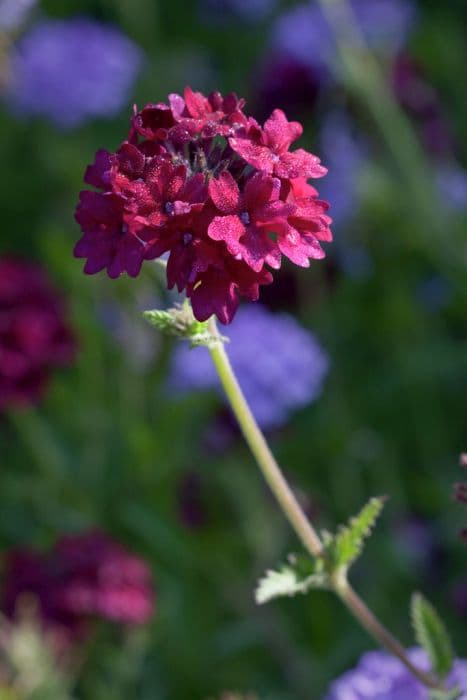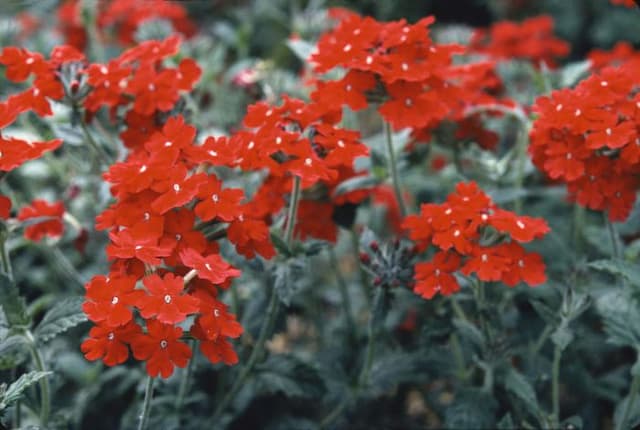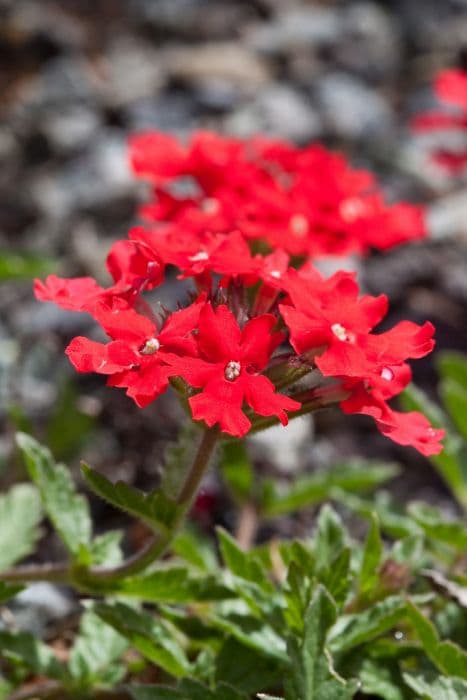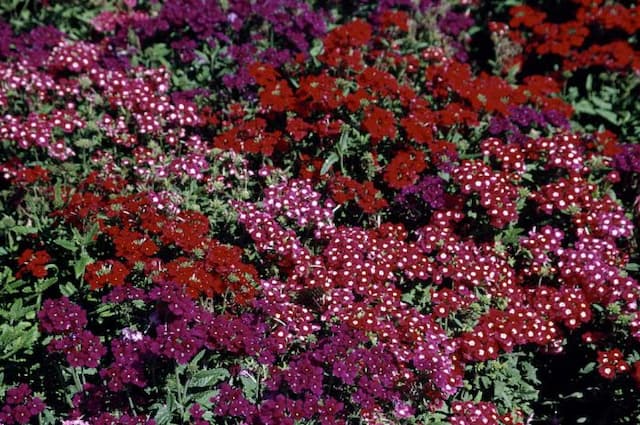Garden Verbena Glandularia Quartz Series

ABOUT
The Glandularia Quartz Series, commonly referred to as Verbenas, showcases a spectacular array of vividly colored flowers. These flowers bloom in clusters at the tip of stems, possessing a rounded form that gives the plant an overall lush and full appearance. The blooms come in a variety of shades including purples, pinks, reds, and whites, often with eye-catching contrasting centers or throats that add a layer of depth and complexity to the flower's appearance. The leaves of the Verbena from the Quartz Series are equally attractive, textured with a feather-like pattern and arranged oppositely on the stems, creating a harmonious backdrop for the vibrant blooms. The foliage has a delicate, lacy edge, and the leaves themselves exhibit a medium to dark green color that complements the floral display. These Verbenas are known for their vigorous growth and spreading habit that creates a dense and ground-covering spread, ideal for cascading over containers, baskets, and garden beds. Their prolific flowering and the striking mix of flower colors make them a popular choice for gardeners looking to add a continuous pop of color throughout the flowering season.
About this plant
 Names
NamesFamily
Verbenaceae.
Synonyms
Moss Verbena, South American Mock Vervain, Quartz Verbena.
Common names
Verbena Quartz Series
 Toxicity
ToxicityTo humans
The Glandularia Quartz Series is commonly known as verbena. Verbena is generally considered non-toxic to humans, and there are no commonly reported symptoms from ingestion. However, individual sensitivities can vary, and someone may experience gastrointestinal discomfort if a large quantity is ingested. Always practice caution and do not consume plants unless they are known to be safe and are intended for culinary use.
To pets
For pets, particularly cats and dogs, verbena is typically not toxic. If a pet ingests part of this plant, there are no widely recognized symptoms of poisoning specific to verbena, as it is generally considered safe for animals. However, as with humans, individual animals may have different sensitivities, and consumption could potentially result in mild gastrointestinal upset. As a precaution, pet owners should discourage their animals from eating non-food plants.
 Characteristics
CharacteristicsLife cycle
Annuals
Foliage type
Deciduous
Color of leaves
Green
Flower color
Varies
Height
0.5 feet (15 cm)
Spread
1 feet (30 cm)
Plant type
Herb
Hardiness zones
9
Native area
Americas
Benefits
 General Benefits
General Benefits- Drought Tolerance: The Glandularia Quartz Series, commonly known as the Verbena, can withstand periods of low water availability, making it suitable for xeriscaping and dry climate gardens.
- Attracts Pollinators: Verbenas are known to attract butterflies and bees to your garden, helping to pollinate other plants.
- Easy to Grow: This plant series is known for being easy to grow and maintain, which is perfect for beginner gardeners or those who prefer low-maintenance gardens.
- Color Variety: Verbena comes in a range of colors, allowing for garden color schemes that can be tailored to personal preferences or design needs.
- Continuous Blooming: The Glandularia Quartz Series often blooms continuously from spring to frost, providing long-lasting color in the garden.
- Compact Size: These verbenas are generally compact and mounding, which makes them ideal for use in containers, hanging baskets, or as a front-of-the-border plant.
- Heat Resistant: They are heat tolerant, making them suitable for sunny and warm garden spots where other plants might struggle.
- Versatility: Glandularia Quartz Verbenas can be utilized in various garden settings, including as bedding plants, in rock gardens, or along walkways for a colorful accent.
 Medical Properties
Medical PropertiesThis plant is not used for medical purposes.
 Air-purifying Qualities
Air-purifying QualitiesThis plant is not specifically known for air purifying qualities.
 Other Uses
Other Uses- Garden ground cover: The Glandularia Quartz Series can be used as a ground cover due to its spreading habit, filling in spaces and suppressing weeds.
- Attracting pollinators: Their vibrant flowers can attract butterflies and other beneficial insects, promoting pollination in the garden.
- Live coloring book: Children can be taught plant structure and flower anatomy by observing the intricate patterns of Glandularia Quartz blooms.
- Potpourri: The flowers can be dried and added to potpourri mixes for a natural, subtle fragrance in the home.
- Educational tool: Horticulture students can study these plants to learn about hybridization and cultivation techniques.
- Photography subject: The diverse and vibrant colors of the Glandularia Quartz Series make them perfect subjects for botanical photographers.
- Borders and edging: Their mounding growth pattern makes them ideal for creating clean lines along garden beds and walkways.
- Hanging baskets: The trailing varieties of the Glandularia Quartz Series are suitable for adding a splash of color to hanging baskets.
- Color therapy: The bright colors of the flowers can be used in color therapy gardens to create a space for relaxation and stress relief.
- Themes gardens: These plants are great for creating specific color-themed gardens or sections within larger garden spaces.
Interesting Facts
 Feng Shui
Feng ShuiThe Glandularia Quartz Series is not used in Feng Shui practice.
 Zodiac Sign Compitability
Zodiac Sign CompitabilityThe Glandularia Quartz Series is not used in astrology practice.
 Plant Symbolism
Plant Symbolism- Beauty: The Glandularia Quartz Series, commonly known as verbena, often represent beauty due to their delicate and vibrant flowers.
- Healing: Verbena has been historically linked to healing properties, symbolizing health and well-being.
- Harmony: The plant’s ability to attract pollinators and contribute to the ecosystem often symbolizes harmony with nature.
- Perseverance: As a plant that can thrive in challenging conditions, verbena symbolizes perseverance and persistence.
- Protection: In some cultures, verbena is believed to have protective qualities, often used in superstitions and rituals.
 Water
WaterFor the common Verbena, watering should be done to keep the soil consistently moist but not soggy. It is best to water deeply once a week, providing about one to two gallons per plant depending on the size and environmental conditions. During hot, dry periods, increase watering frequency to twice a week. Always check the top inch of soil for dryness before watering to avoid overwatering, which can lead to root rot.
 Light
LightVerbena thrives in full sun conditions, meaning it requires at least six to eight hours of direct sunlight daily. The best spot is an open area that receives uninterrupted sun throughout the day. If growing indoors, a south-facing window is ideal to ensure sufficient light for vibrant blooms.
 Temperature
TemperatureVerbena prefers warm conditions and will bloom best when daytime temperatures are between 65 to 85 degrees Fahrenheit. They can survive minimum temperatures of 20 degrees Fahrenheit but are susceptible to damage if the temperature drops lower. The ideal temperature range to foster growth and flowering is 70 to 80 degrees Fahrenheit.
 Pruning
PruningPruning Verbena promotes a fuller growth and encourages continuous blooming. Deadhead spent blooms regularly to prolong flowering. A more thorough pruning can be done in late winter or early spring, cutting back the plant by a third to foster new and healthy shoots. Pruning is also an opportunity to shape the plant and remove any damaged or diseased stems.
 Cleaning
CleaningAs needed
 Soil
SoilFor the best soil mix for Verbena, commonly known as the Glandularia Quartz Series, use a well-draining potting mix with added perlite or coarse sand to enhance drainage. The soil pH should be slightly acidic to slightly alkaline, ranging from 6.0 to 7.5.
 Repotting
RepottingVerbenas, such as the Glandularia Quartz Series, should be repotted every 1 to 2 years to refresh the soil and accommodate root growth. Choose a container just one size larger to avoid excessively damp soil, which can cause root rot.
 Humidity & Misting
Humidity & MistingThe Verbena, or Glandularia Quartz Series, does best with moderate humidity levels. They can tolerate some dry air but prefer a range of 40-50% humidity, typical of outdoor conditions.
 Suitable locations
Suitable locationsIndoor
Place Verbena in a sunny spot and water regularly.
Outdoor
Plant Verbena in full sun and well-draining soil.
Hardiness zone
6-10 USDA
 Life cycle
Life cycleThe life of the Glandularia Quartz Series, commonly known as Verbena, begins with seed germination when temperatures reach between 65-75°F, usually in early spring. After sprouting, the seedlings grow and establish a root system, followed by the development of foliage. As the plant matures, it undergoes vegetative growth, producing a mound of serrated leaves and branching stems. Verbena enters its flowering stage in late spring to summer, displaying clusters of small, vibrant blooms that attract pollinators like bees and butterflies. Following pollination, the plant sets seed, ensuring the next generation, and this may be interspersed with additional flowering periods until the first frosts. Finally, as a perennial in warm climates (or annual in cooler regions), the plant either dies back in the winter, to regrow from the rootstock the following spring, or completes its life cycle if grown as an annual.
 Propogation
PropogationPropogation time
Spring to Summer
Propogation: The Glandularia Quartz Series, commonly known as verbena, is frequently propagated through cuttings. This is because the cultivars in the Quartz Series are often hybrids and seeds may not come true to type, meaning they may not retain the desirable characteristics of the parent plant. For cuttings, the ideal time is usually in late spring to early summer when the plant is actively growing. To propagate by cuttings, a gardener would take a healthy stem about 4 to 6 inches long, strip the lower leaves, and then dip the cut end in rooting hormone powder. Afterwards, the stem is planted in a mix of peat and perlite or a well-draining potting mix, ensuring high humidity and consistent moisture without waterlogging. Cuttings typically root within a few weeks, at which point they can be transplanted to a more permanent location.
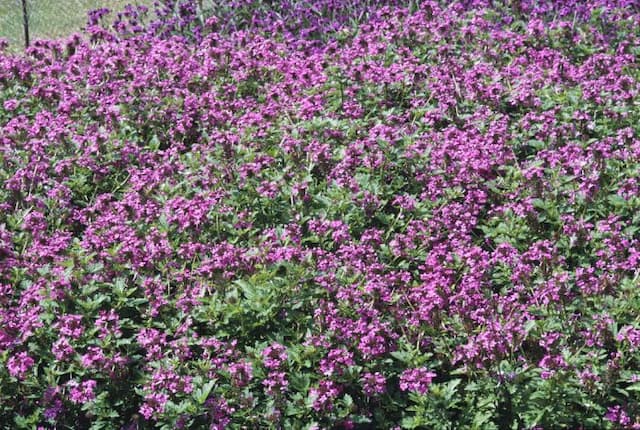
![Vervain [Donalena Lavender Grace]](/_next/image?url=https%3A%2F%2Fplants-admin.emdemapps.com%2Fimages%2Fplants%2F%2Fimages%2F604b575c837e7.png&w=640&q=75)
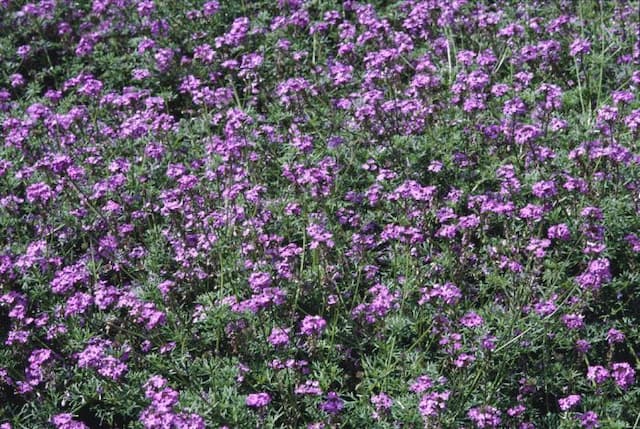
![Vervain [Endurascape Pink Bicolor]](/_next/image?url=https%3A%2F%2Fplants-admin.emdemapps.com%2Fimages%2Fplants%2F%2Fimages%2F604b594e749b0.png&w=640&q=75)
![Vervain [Seabrook's Lavender]](/_next/image?url=https%3A%2F%2Fplants-admin.emdemapps.com%2Fimages%2Fplants%2F%2Fimages%2F604b650ea9729.png&w=640&q=75)

